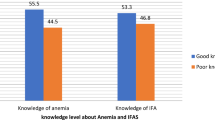Play all audios:

ABSTRACT OBJECTIVE: Intervention with iron supplementation, deworming, and information, education and communication (IEC) to improve the haematological status among each of the three
trimesters of pregnant women in a rural community. DESIGN: A community-based study was carried out using a two-group pre–post experimental design in a rural community. SETTING: Two rural
blocks in Vellore district were selected for the study. KV Kuppam block with a population of 120, 000 and the adjacent Gudiyatham block with a population of 132, 000 served as study and
control areas for the study. SUBJECTS: Using a multistage sampling, initially 50% of the _panchayats_, the local village administrative units, were randomly selected and all pregnant women
were the subjects. In the pre-intervention survey 458 and 387 pregnant women had haemoglobin tested and the post-intervention survey covered 403 and 425 pregnant women in the study and
control areas, respectively. Similarly serum ferritin was tested in a randomly selected sub-sample with 254 and 191 pregnant women before intervention and in 216 and 223 pregnant women after
intervention in both study and control areas, respectively. INTERVENTION: Iron supplementation and deworming were provided to all pregnant women in the study area from the fourth month of
their pregnancy. An intensive information, education and communication was carried out with facts on anaemia and diet modification to each pregnant woman, using a one-to-one approach in the
community, and a group method in the mobile clinics. This was carried out for a period of 18 months. RESULTS: A significant decrease in the prevalence of anaemia was found, from 56.1% to
25.07% (_P_<0.001), 73.4% to 49.2% (_P_<0.001) and 68.8% to 56.8% (_P_<0.01) among women in the first, second and third trimesters, respectively, in the intervention area.
Significant (_P_<0.001) increases in the mean haemoglobin of 0.85 g/dl (95% CI 10.18–10.84, 11.09–11.63), 0.59 g/dl (95% CI 9.98–10.34, 10.55–10.95) and 0.36 g/dl (95% CI 9.93–10.33,
10.25–10.73) were also observed in each of the groups. CONCLUSION: A comprehensive community-based intervention with iron supplementation, helminthic treatment and increase in knowledge
using IEC through effective strategies can improve the haematological status of pregnant women in each trimester. SPONSORSHIP: Mother Care Project, John Snow Inc., Funded by the United
States Agency for International Development (USAID). _European Journal of Clinical Nutrition_ (2000) 54, 490–493 Access through your institution Buy or subscribe This is a preview of
subscription content, access via your institution ACCESS OPTIONS Access through your institution Subscribe to this journal Receive 12 print issues and online access $259.00 per year only
$21.58 per issue Learn more Buy this article * Purchase on SpringerLink * Instant access to full article PDF Buy now Prices may be subject to local taxes which are calculated during checkout
ADDITIONAL ACCESS OPTIONS: * Log in * Learn about institutional subscriptions * Read our FAQs * Contact customer support SIMILAR CONTENT BEING VIEWED BY OTHERS COMPLIANCE TO IRON FOLIC ACID
SUPPLEMENTATION AND ITS ASSOCIATED FACTORS AMONG PREGNANT WOMEN ATTENDING ANTENATAL CLINIC IN WONDO DISTRICT: A CROSS-SECTIONAL STUDY Article Open access 14 October 2023 COMPLIANCE TO IRON
FOLIC ACID CONSUMPTION AND FACTORS ASSOCIATED AMONG ANTENATAL CARE ATTENDANT MOTHERS IN SOUTHERN ETHIOPIA Article Open access 09 November 2024 COMPLIANCE LEVEL AND ASSOCIATED FACTORS OF IRON
FOLIC ACID SUPPLEMENTATION AMONG PREGNANT WOMEN IN NORTH SHOA ZONE, ETHIOPIA Article Open access 11 June 2024 AUTHOR INFORMATION AUTHORS AND AFFILIATIONS * RUHSA Department, Christian
Medical College and Hospital, RUHSA Campus PO 632 209, Vellore District, Tamil Nadu, India R Abel, J Rajaratnam, A Kalaimani & S Kirubakaran Authors * R Abel View author publications You
can also search for this author inPubMed Google Scholar * J Rajaratnam View author publications You can also search for this author inPubMed Google Scholar * A Kalaimani View author
publications You can also search for this author inPubMed Google Scholar * S Kirubakaran View author publications You can also search for this author inPubMed Google Scholar CONTRIBUTIONS
_Guarantors:_ R Abel and J Rajaratnam. _Contributors:_ RA was the investigator. JR was the coinvestigator. AK and SK were implementors. ADDITIONAL INFORMATION This publication was made
possible through support provided by the Office of Health and Nutrition, United States Agency for International Development (USAID), under the terms of contract no. HRN-C-00-9300038-00 and
John Snow Incorporated (JSI). The contents and opinions expressed herein are those of the authors and do not necessarily reflect the views of USAID and JSI. RIGHTS AND PERMISSIONS Reprints
and permissions ABOUT THIS ARTICLE CITE THIS ARTICLE Abel, R., Rajaratnam, J., Kalaimani, A. _et al._ Can iron status be improved in each of the three trimesters? A community-based study.
_Eur J Clin Nutr_ 54, 490–493 (2000). https://doi.org/10.1038/sj.ejcn.1601044 Download citation * Received: 22 October 1999 * Revised: 03 February 2000 * Accepted: 20 February 2000 *
Published: 21 June 2000 * Issue Date: 01 June 2000 * DOI: https://doi.org/10.1038/sj.ejcn.1601044 SHARE THIS ARTICLE Anyone you share the following link with will be able to read this
content: Get shareable link Sorry, a shareable link is not currently available for this article. Copy to clipboard Provided by the Springer Nature SharedIt content-sharing initiative
KEYWORDS * iron * deworming * haemoglobin * ferritin * trimesters * community-based study
